Alexander S. Ecker
Institute of Computer Science and Campus Institute Data Science, University of Goettingen, Germany, Max Planck Institute for Dynamics and Self-Organization, Goettingen, Germany
What should a neuron aim for? Designing local objective functions based on information theory
Dec 03, 2024



Abstract:In modern deep neural networks, the learning dynamics of the individual neurons is often obscure, as the networks are trained via global optimization. Conversely, biological systems build on self-organized, local learning, achieving robustness and efficiency with limited global information. We here show how self-organization between individual artificial neurons can be achieved by designing abstract bio-inspired local learning goals. These goals are parameterized using a recent extension of information theory, Partial Information Decomposition (PID), which decomposes the information that a set of information sources holds about an outcome into unique, redundant and synergistic contributions. Our framework enables neurons to locally shape the integration of information from various input classes, i.e. feedforward, feedback, and lateral, by selecting which of the three inputs should contribute uniquely, redundantly or synergistically to the output. This selection is expressed as a weighted sum of PID terms, which, for a given problem, can be directly derived from intuitive reasoning or via numerical optimization, offering a window into understanding task-relevant local information processing. Achieving neuron-level interpretability while enabling strong performance using local learning, our work advances a principled information-theoretic foundation for local learning strategies.
MNIST-Nd: a set of naturalistic datasets to benchmark clustering across dimensions
Oct 21, 2024Abstract:Driven by advances in recording technology, large-scale high-dimensional datasets have emerged across many scientific disciplines. Especially in biology, clustering is often used to gain insights into the structure of such datasets, for instance to understand the organization of different cell types. However, clustering is known to scale poorly to high dimensions, even though the exact impact of dimensionality is unclear as current benchmark datasets are mostly two-dimensional. Here we propose MNIST-Nd, a set of synthetic datasets that share a key property of real-world datasets, namely that individual samples are noisy and clusters do not perfectly separate. MNIST-Nd is obtained by training mixture variational autoencoders with 2 to 64 latent dimensions on MNIST, resulting in six datasets with comparable structure but varying dimensionality. It thus offers the chance to disentangle the impact of dimensionality on clustering. Preliminary common clustering algorithm benchmarks on MNIST-Nd suggest that Leiden is the most robust for growing dimensions.
Computer Vision for Primate Behavior Analysis in the Wild
Jan 29, 2024Abstract:Advances in computer vision as well as increasingly widespread video-based behavioral monitoring have great potential for transforming how we study animal cognition and behavior. However, there is still a fairly large gap between the exciting prospects and what can actually be achieved in practice today, especially in videos from the wild. With this perspective paper, we want to contribute towards closing this gap, by guiding behavioral scientists in what can be expected from current methods and steering computer vision researchers towards problems that are relevant to advance research in animal behavior. We start with a survey of the state-of-the-art methods for computer vision problems that are directly relevant to the video-based study of animal behavior, including object detection, multi-individual tracking, (inter)action recognition and individual identification. We then review methods for effort-efficient learning, which is one of the biggest challenges from a practical perspective. Finally, we close with an outlook into the future of the emerging field of computer vision for animal behavior, where we argue that the field should move fast beyond the common frame-by-frame processing and treat video as a first-class citizen.
The Sensorium competition on predicting large-scale mouse primary visual cortex activity
Jun 17, 2022
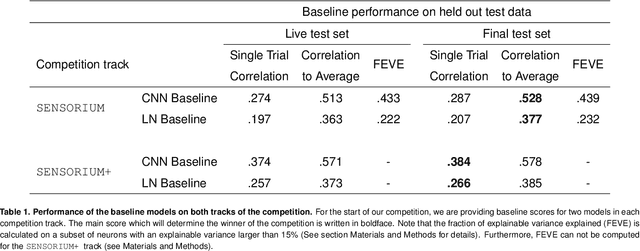
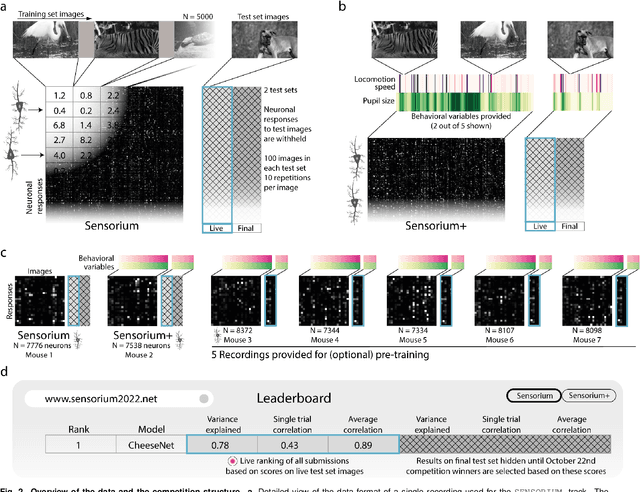
Abstract:The neural underpinning of the biological visual system is challenging to study experimentally, in particular as the neuronal activity becomes increasingly nonlinear with respect to visual input. Artificial neural networks (ANNs) can serve a variety of goals for improving our understanding of this complex system, not only serving as predictive digital twins of sensory cortex for novel hypothesis generation in silico, but also incorporating bio-inspired architectural motifs to progressively bridge the gap between biological and machine vision. The mouse has recently emerged as a popular model system to study visual information processing, but no standardized large-scale benchmark to identify state-of-the-art models of the mouse visual system has been established. To fill this gap, we propose the Sensorium benchmark competition. We collected a large-scale dataset from mouse primary visual cortex containing the responses of more than 28,000 neurons across seven mice stimulated with thousands of natural images, together with simultaneous behavioral measurements that include running speed, pupil dilation, and eye movements. The benchmark challenge will rank models based on predictive performance for neuronal responses on a held-out test set, and includes two tracks for model input limited to either stimulus only (Sensorium) or stimulus plus behavior (Sensorium+). We provide a starting kit to lower the barrier for entry, including tutorials, pre-trained baseline models, and APIs with one line commands for data loading and submission. We would like to see this as a starting point for regular challenges and data releases, and as a standard tool for measuring progress in large-scale neural system identification models of the mouse visual system and beyond.
Self-supervised Representation Learning of Neuronal Morphologies
Jan 18, 2022
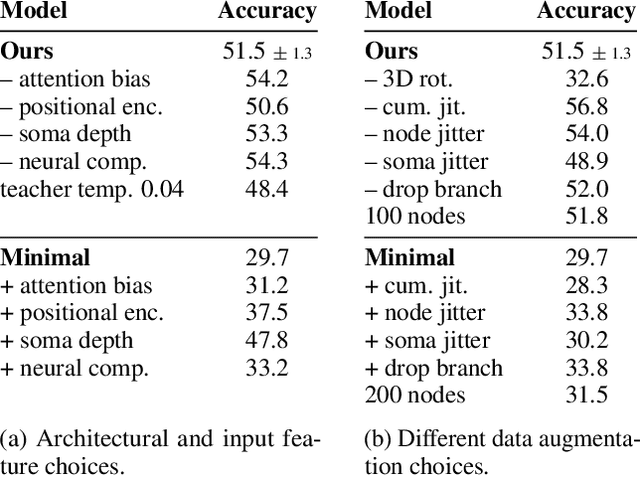
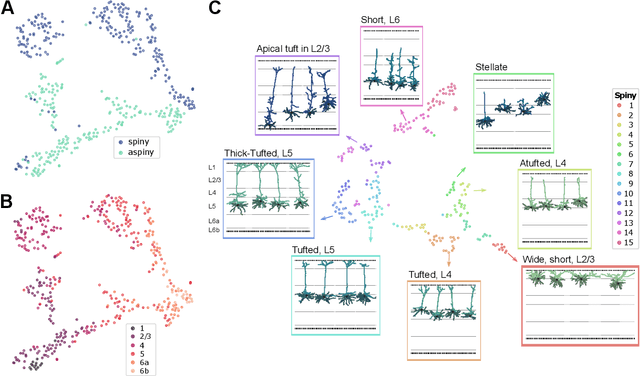
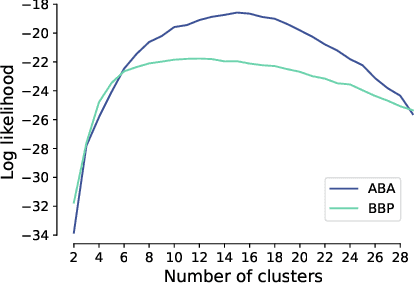
Abstract:Understanding the diversity of cell types and their function in the brain is one of the key challenges in neuroscience. The advent of large-scale datasets has given rise to the need of unbiased and quantitative approaches to cell type classification. We present GraphDINO, a purely data-driven approach to learning a low dimensional representation of the 3D morphology of neurons. GraphDINO is a novel graph representation learning method for spatial graphs utilizing self-supervised learning on transformer models. It combines attention-based global interaction between nodes and classic graph convolutional processing. We show, in two different species and cortical areas, that this method is able to yield morphological cell type clustering that is comparable to manual feature-based classification and shows a good correspondence to expert-labeled cell types. Our method is applicable beyond neuroscience in settings where samples in a dataset are graphs and graph-level embeddings are desired.
Prompt-Based Multi-Modal Image Segmentation
Dec 18, 2021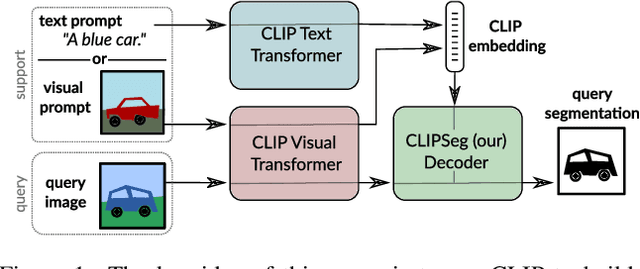

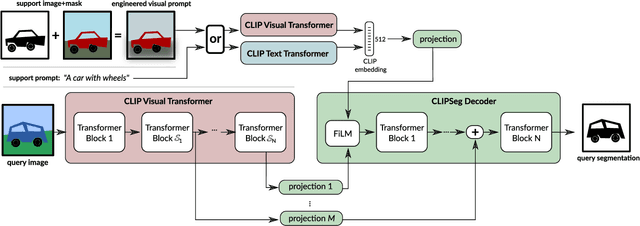

Abstract:Image segmentation is usually addressed by training a model for a fixed set of object classes. Incorporating additional classes or more complex queries later is expensive as it requires re-training the model on a dataset that encompasses these expressions. Here we propose a system that can generate image segmentations based on arbitrary prompts at test time. A prompt can be either a text or an image. This approach enables us to create a unified model (trained once) for three common segmentation tasks, which come with distinct challenges: referring expression segmentation, zero-shot segmentation and one-shot segmentation. We build upon the CLIP model as a backbone which we extend with a transformer-based decoder that enables dense prediction. After training on an extended version of the PhraseCut dataset, our system generates a binary segmentation map for an image based on a free-text prompt or on an additional image expressing the query. Different variants of the latter image-based prompts are analyzed in detail. This novel hybrid input allows for dynamic adaptation not only to the three segmentation tasks mentioned above, but to any binary segmentation task where a text or image query can be formulated. Finally, we find our system to adapt well to generalized queries involving affordances or properties. Source code: https://eckerlab.org/code/clipseg
Closing the Generalization Gap in One-Shot Object Detection
Nov 09, 2020

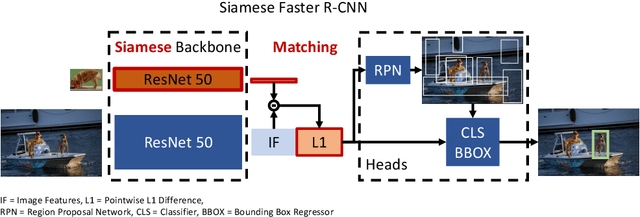

Abstract:Despite substantial progress in object detection and few-shot learning, detecting objects based on a single example - one-shot object detection - remains a challenge: trained models exhibit a substantial generalization gap, where object categories used during training are detected much more reliably than novel ones. Here we show that this generalization gap can be nearly closed by increasing the number of object categories used during training. Our results show that the models switch from memorizing individual categories to learning object similarity over the category distribution, enabling strong generalization at test time. Importantly, in this regime standard methods to improve object detection models like stronger backbones or longer training schedules also benefit novel categories, which was not the case for smaller datasets like COCO. Our results suggest that the key to strong few-shot detection models may not lie in sophisticated metric learning approaches, but instead in scaling the number of categories. Future data annotation efforts should therefore focus on wider datasets and annotate a larger number of categories rather than gathering more images or instances per category.
Unmasking the Inductive Biases of Unsupervised Object Representations for Video Sequences
Jun 12, 2020

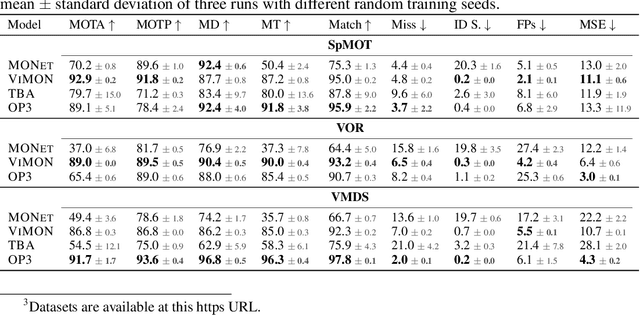

Abstract:Perceiving the world in terms of objects is a crucial prerequisite for reasoning and scene understanding. Recently, several methods have been proposed for unsupervised learning of object-centric representations. However, since these models have been evaluated with respect to different downstream tasks, it remains unclear how they compare in terms of basic perceptual abilities such as detection, figure-ground segmentation and tracking of individual objects. In this paper, we argue that the established evaluation protocol of multi-object tracking tests precisely these perceptual qualities and we propose a new benchmark dataset based on procedurally generated video sequences. Using this benchmark, we compare the perceptual abilities of three state-of-the-art unsupervised object-centric learning approaches. Towards this goal, we propose a video-extension of MONet, a seminal object-centric model for static scenes, and compare it to two recent video models: OP3, which exploits clustering via spatial mixture models, and TBA, which uses an explicit factorization via spatial transformers. Our results indicate that architectures which employ unconstrained latent representations based on per-object variational autoencoders and full-image object masks are able to learn more powerful representations in terms of object detection, segmentation and tracking than the explicitly parameterized spatial transformer based architecture. We also observe that none of the methods are able to gracefully handle the most challenging tracking scenarios, suggesting that our synthetic video benchmark may provide fruitful guidance towards learning more robust object-centric video representations.
Benchmarking Robustness in Object Detection: Autonomous Driving when Winter is Coming
Jul 17, 2019



Abstract:The ability to detect objects regardless of image distortions or weather conditions is crucial for real-world applications of deep learning like autonomous driving. We here provide an easy-to-use benchmark to assess how object detection models perform when image quality degrades. The three resulting benchmark datasets, termed Pascal-C, Coco-C and Cityscapes-C, contain a large variety of image corruptions. We show that a range of standard object detection models suffer a severe performance loss on corrupted images (down to 30-60% of the original performance). However, a simple data augmentation trick - stylizing the training images - leads to a substantial increase in robustness across corruption type, severity and dataset. We envision our comprehensive benchmark to track future progress towards building robust object detection models. Benchmark, code and data are available at: http://github.com/bethgelab/robust-detection-benchmark
One-Shot Instance Segmentation
Nov 28, 2018


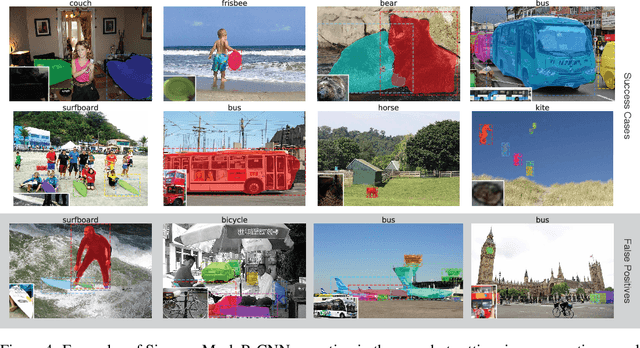
Abstract:We tackle one-shot visual search by example for arbitrary object categories: Given an example image of a novel reference object, find and segment all object instances of the same category within a scene. To address this problem, we propose Siamese Mask R-CNN. It extends Mask R-CNN by a Siamese backbone encoding both reference image and scene, allowing it to target detection and segmentation towards the reference category. We use Siamese Mask R-CNN to perform one-shot instance segmentation on MS-COCO, demonstrating that it can detect and segment objects of novel categories it was not trained on, and without using mask annotations at test time. Our results highlight challenges of the one-shot setting: while transferring knowledge about instance segmentation to novel object categories not used during training works very well, targeting the detection and segmentation networks towards the reference category appears to be more difficult. Our work provides a first strong baseline for one-shot instance segmentation and will hopefully inspire further research in this relatively unexplored field.
 Add to Chrome
Add to Chrome Add to Firefox
Add to Firefox Add to Edge
Add to Edge